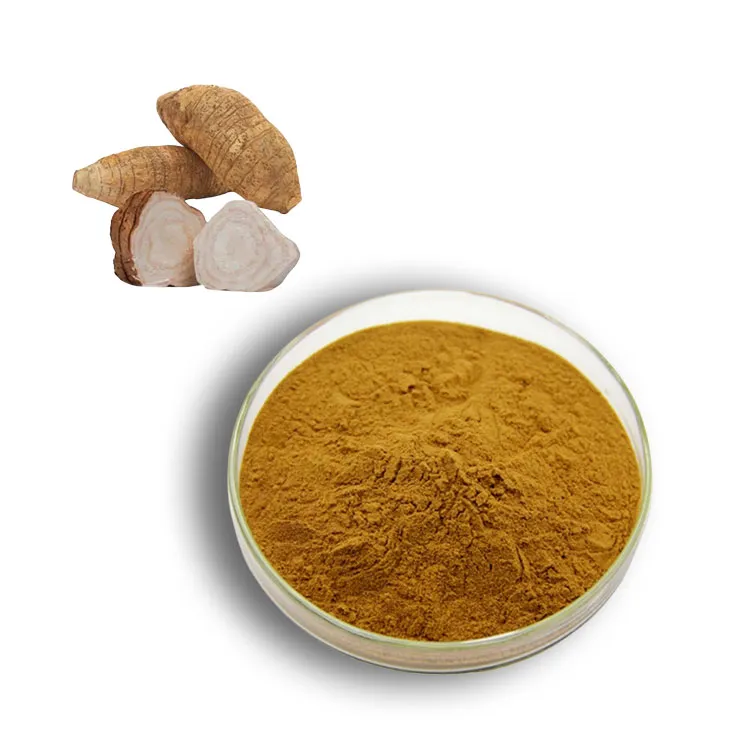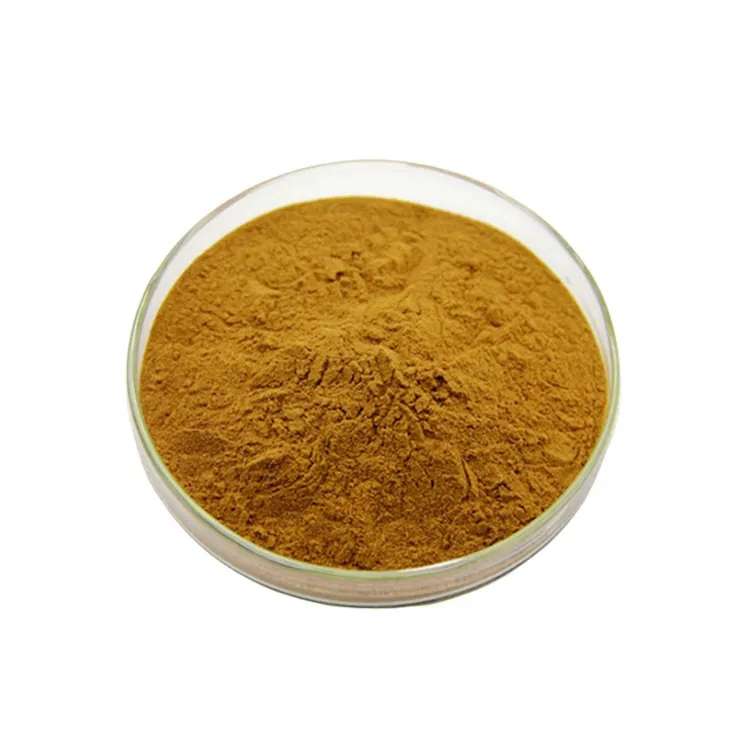- 0086-571-85302990
- sales@greenskybio.com
Pueraria Lobata Extract: Nature's Best - Kept Secret.
2024-11-12

Introduction
Pueraria lobata, also known as kudzu, is a plant that has been part of human history for centuries. Its extract is a natural substance with a wealth of potential benefits that are only beginning to be fully understood. This extract has been shrouded in mystery, a true "conservative secret" of nature, and it is time to unearth its secrets from various aspects such as its chemical composition, traditional uses in different cultures, and modern scientific research findings.

Chemical Composition of Pueraria Lobata Extract
The extract of Pueraria lobata is a complex mixture of various chemical compounds. Isoflavones are one of the most prominent components. Isoflavones such as puerarin, daidzin, and genistin play crucial roles in the potential health - promoting effects of the extract.
Puerarin, in particular, is a major isoflavone in Pueraria Lobata Extract. It has been the focus of much scientific research due to its antioxidant properties. Antioxidants are important as they can help neutralize free radicals in the body, which are unstable molecules that can cause damage to cells and contribute to various diseases.
Besides isofavones, the extract also contains other substances like flavonoids and polysaccharides. Flavonoids contribute to the overall antioxidant activity of the extract and may also have anti - inflammatory properties. Polysaccharides, on the other hand, are thought to have immunomodulatory effects, which means they can help regulate the immune system.

Traditional Uses in Different Cultures
Traditional Chinese Medicine
In Traditional Chinese Medicine (TCM), Pueraria lobata has a long history of use. It is often used to relieve muscle tension and pain. For example, it has been used in the treatment of neck and shoulder pain. TCM practitioners believe that it can help promote the circulation of Qi (vital energy) and blood in the body, which is thought to be beneficial for overall health.
It is also used for its potential to alleviate fever and thirst. In ancient Chinese medical texts, there are records of using Pueraria lobata to treat febrile diseases and to quench thirst during illness.
Traditional Japanese and Korean Uses
In Japan and Korea, Pueraria lobata has also been used in traditional medicine. In Japan, it has been used in a similar way to China for treating various ailments related to muscle pain and fever. In Korea, it has been part of traditional herbal remedies, and its use has been passed down through generations.

Modern Scientific Research Findings
Cardiovascular Health
Research has shown that Pueraria Lobata Extract may have positive effects on cardiovascular health. The isoflavones present in the extract, such as puerarin, may help lower blood pressure. A study found that puerarin can relax blood vessels, which in turn can lead to a reduction in blood pressure levels.
It may also have a role in cholesterol management. Some evidence suggests that the extract can help lower LDL (low - density lipoprotein) cholesterol levels, which are often referred to as "bad" cholesterol. By reducing LDL cholesterol, it may help reduce the risk of cardiovascular diseases such as heart attacks and strokes.
Neurological Benefits
The extract has shown potential in the field of neurology. Puerarin has been studied for its possible effects on improving cognitive function. Some research indicates that it may help enhance memory and learning abilities. It may also have a protective effect on neurons, which could be beneficial in neurodegenerative diseases such as Alzheimer's and Parkinson's.
Furthermore, Pueraria lobata extract may help relieve headaches. In some cases, it has been used as an alternative or complementary treatment for migraines. The mechanisms behind this may be related to its ability to relax blood vessels in the head and reduce inflammation.
Anti - Diabetic Effects
There is growing evidence that Pueraria lobata extract may have anti - diabetic properties. It may help regulate blood sugar levels by improving insulin sensitivity. Insulin is a hormone that is crucial for the body to regulate blood sugar, and when the body becomes resistant to insulin, it can lead to diabetes. The extract may also have an effect on glucose metabolism in the liver, which is an important organ in the regulation of blood sugar.
Anti - Inflammatory and Antioxidant Activities
As mentioned earlier, the isoflavones and flavonoids in Pueraria lobata extract contribute to its antioxidant activity. These compounds can scavenge free radicals in the body, reducing oxidative stress. Oxidative stress is associated with many chronic diseases, including cancer, heart disease, and diabetes.
The extract also has anti - inflammatory properties. Inflammation is a natural response of the body to injury or infection, but chronic inflammation can be harmful. Pueraria lobata extract may help reduce chronic inflammation, which could have implications for the treatment of inflammatory diseases such as arthritis.
Conclusion
Pueraria lobata extract is truly a natural substance with hidden values waiting to be fully explored. Its complex chemical composition, rich traditional uses in different cultures, and promising modern scientific research findings all point to its potential as a valuable natural remedy. However, more research is still needed to fully understand its mechanisms of action and to ensure its safety and efficacy for various applications. As we continue to uncover the secrets of this "nature's most conservative secret", we may find new ways to use it for the benefit of human health.
FAQ:
What are the main chemical components in Pueraria lobata extract?
Pueraria lobata extract contains various chemical components. One of the major ones is isoflavones, such as daidzein, daidzin, Genistein, and puerarin. These isoflavones are phytoestrogens which have antioxidant, anti - inflammatory and other potential health - promoting properties.
What are the traditional uses of Pueraria lobata in Asian cultures?
In Asian cultures, especially in traditional Chinese medicine, Pueraria lobata has been used for a long time. It was often used to relieve fevers, as it has a certain cooling effect on the body. Also, it was used for treating thirst, headache, and some symptoms related to alcohol intoxication. In addition, it was sometimes used in prescriptions for promoting blood circulation and relieving muscle tension.
What have modern scientific research findings shown about Pueraria lobata extract?
Modern scientific research has found that Pueraria lobata extract has several potential benefits. For example, its isoflavones may help in reducing the risk of cardiovascular diseases by improving lipid profiles and reducing blood pressure. It may also have potential anti - diabetic effects as it can help regulate blood glucose levels. Moreover, some studies suggest that it has anti - cancer properties, although more research is needed in this area. Additionally, it has shown potential in protecting the liver from damage.
How is Pueraria lobata extract usually obtained?
Pueraria lobata extract is typically obtained through extraction processes. The roots of Pueraria lobata are often used as the raw material. They can be processed using solvents such as ethanol or water. Through techniques like maceration, percolation or Soxhlet extraction, the active components are separated from the plant material to obtain the extract.
Are there any side effects associated with Pueraria lobata extract?
While Pueraria lobata extract has many potential benefits, there may be some side effects in certain cases. For example, in high doses, it may cause gastrointestinal discomfort such as nausea and diarrhea. Also, due to its phytoestrogen content, there may be concerns for individuals with hormone - sensitive conditions, although the evidence for significant adverse effects in this regard is not conclusive. It is always important to consult a healthcare professional before using any extract in large amounts or for therapeutic purposes.
Related literature
- Chemical Constituents and Pharmacological Activities of Pueraria lobata: A Review"
- "Traditional Uses and Modern Research of Pueraria lobata in Health Promotion"
- "Pueraria lobata Extract: A Promising Natural Product in Biomedical Research"
- ▶ Hesperidin
- ▶ citrus bioflavonoids
- ▶ plant extract
- ▶ lycopene
- ▶ Diosmin
- ▶ Grape seed extract
- ▶ Sea buckthorn Juice Powder
- ▶ Beetroot powder
- ▶ Hops Extract
- ▶ Artichoke Extract
- ▶ Reishi mushroom extract
- ▶ Astaxanthin
- ▶ Green Tea Extract
- ▶ Curcumin Extract
- ▶ Horse Chestnut Extract
- ▶ Other Problems
- ▶ Boswellia Serrata Extract
- ▶ Resveratrol Extract
- ▶ Marigold Extract
- ▶ Grape Leaf Extract
- ▶ blog3
- ▶ blog4
- ▶ blog5
-
Organic Tongkat Ali extract powder factory.
2024-11-12
-
How to make powder with ashwagandha extract.
2024-11-12
-
Rosehip extract manufacturers from China.
2024-11-12
-
The best cat's claw extract in nature.
2024-11-12
-
Chinese Dandelion Leaf Extract Suppliers.
2024-11-12
-
Bilberry Extract
2024-11-12
-
Dandelion Root Extract
2024-11-12
-
Stevia Extract
2024-11-12
-
Hawthorn Extract
2024-11-12
-
Selenium yeast
2024-11-12
-
Acai Berry Extract
2024-11-12
-
Tinospora cordifolia extract
2024-11-12
-
Tormentil Extract
2024-11-12
-
Sophora Flavescens Root Extract
2024-11-12
-
Natural grape seed extract
2024-11-12





















